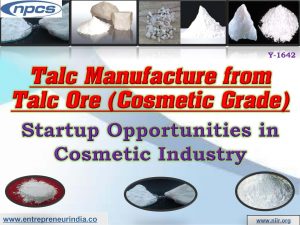Talc (Cosmetic Grade) Manufacture from Talc Ore

Talc Manufacture from Talc Ore (Cosmetic Grade). Startup Opportunities in Cosmetic Industry.
Talc may be a monoclinic mineral with a sheet structure almost like the micas. Talc has perfect cleavage that follows planes between the weakly bonded sheets. These sheets are held together only by van der Waals bonds, which allows them to slide past each other easily. This characteristic is responsible for talc’s extreme softness, its greasy, soapy feel, and its value as a high-temperature lubricant. Talc is usually green, white, gray, brown, or colorless. It’s a translucent mineral with a pearly luster.
Related Project- Talc from Talc Ore (cosmetic Grade)
Talcum powder is formed from talc, a mineral made up mainly of the elements magnesium, silicon, and oxygen. As a powder, it absorbs moisture well and helps hamper on friction, making it useful for keeping skin dry and helping to stop rashes. It’s widely utilized in cosmetic products like baby powder and human body and facial powders, as well as during a number of other consumer products.
Uses
Talc are often used as an ingredient in paints, roofing materials, ceramics, insecticides, rubber, talcum and insecticides among others. It’s also utilized by the cosmetics industry, pulp and paper industry and food industry. Talc is usually wont to manufacture laboratory countertops and electrical switchboards because of its resistance to heat, acids and electricity. It’s utilized by the cosmetic industry as a lubricant and as a filler by the pulp and paper industry. Talc is extensively wont to make astringent baby powders that prevent rashes covered by a diaper. Talc is used by the pharmaceutical industry as a glidant (a substance that’s added to powder to boost its flow ability) and by the food industry as an additive. In medicine, talc is used as a pleurodesis agent to forestall pneumothorax or recurrent pleural effusion. Talc is additionally an efficient dispersing agent and anti-caking agent and helps fertilizer plants and animal feeds to function efficiently and might be used for fertilizers.
Related Projects: – Cosmetics, Perfumery Compounds, Flavours & Essential Oils, Essential Perfume Oil, Cosmetics Fragrances
Talc Mining and Processing
Most talc in the United States is produced from an open pit mine where the rock is drilled, blasted, and partially crushed in the mining operation. The highest grade ores are produced by selective mining and sorting operations.
Great care is taken during the mining process to avoid contaminating the talc with other rock materials. These other materials can have an adverse effect on the color of the product. Contamination can introduce hard particles that cause problems in applications where talc is being used because of its softness or lubricating properties.
Partially crushed rock is taken from the mine to a mill, where it is further reduced in particle size. Impurities are sometimes removed by froth flotation or mechanical processing. The mills usually produce crushed or finely ground talc that meets customer requirements for particle size, brightness, composition, and other properties.
Related Books:- Cosmetics And Beauty Products (Ayurvedic, Herbal) Formulation And Manufacturing Technology
Market Outlook
The global Talc market size is expected to gain market growth in the forecast period of 2020 to 2025, with a CAGR of 1.9%% in the forecast period of 2020 to 2025 and will expected to reach USD 1511.7 million by 2025, from USD 1399.8 million in 2019. Increasing demand for industrial and marine coatings is also likely to boost the demand for talc, as it is used in industrial coatings, which provide benefits, such as corrosion protection, solvent reduction, and good adhesion.
The paper and pulp industry remains the largest global end market for talc and is the key driving factor for the talc Industry. The automotive industry, ceramics industry and the paint and coatings industry are the other major consumers of talc. The use of talc as a filler in the paper industry is declining today but the use of talc for the manufacture of under the hood automotive parts is substantially increasing that has further lead to surge in demand for talc by the automotive industry.
Related Video:- How to Start Cosmetics Manufacturing Business
Slow Growth of the Pulp & Paper Industry Due To Digitization
The pulp & paper industry has been growing at a slow pace across the world because of digitization, which has reduced the demand for graphic papers. The growth of the pulp & paper industry has been slower in North American and European countries as compared to countries within the Asia Pacific region, which is expected to restrain the growth of the talc market. Moreover, talc is being replaced by biotechnological solutions in applications like pitch control within the pulp & paper industry. These biotechnological solutions use enzymes or fungi for pitch control. Hence, the utilization of talc within the pulp & paper industry has declined, thereby leading to the decreased demand for talc from this industry.
Increasing demand for talc from the automotive industry, rapid industrialization, increased disposable incomes of the middle-class populations of emerging economies, and increasing R&D activities for the event of recent grades of talc are opportunities for the growth of the talc market.
Market Research: – Market Research Report
Key Players
- Imerys
- Mineral Technologies Inc.
- IMI Fabi SpA
- Golcha Group
Key players in the talc market include Imerys (France), Mondo Minerals (Netherlands), Minerals Technologies (US), IMI Fabi (Italy), Golcha Minerals (India), and Nippon Talc (Japan), among others.